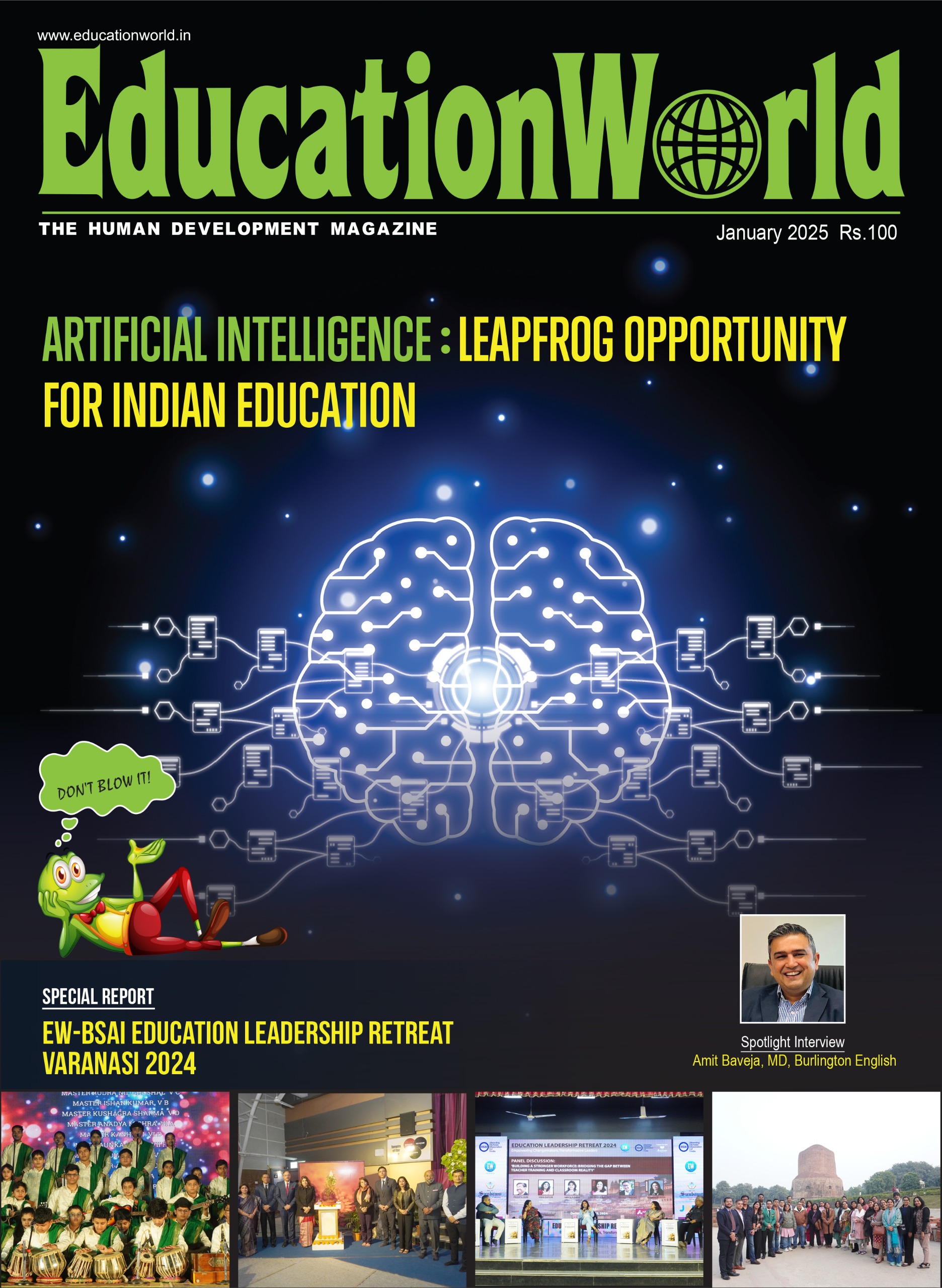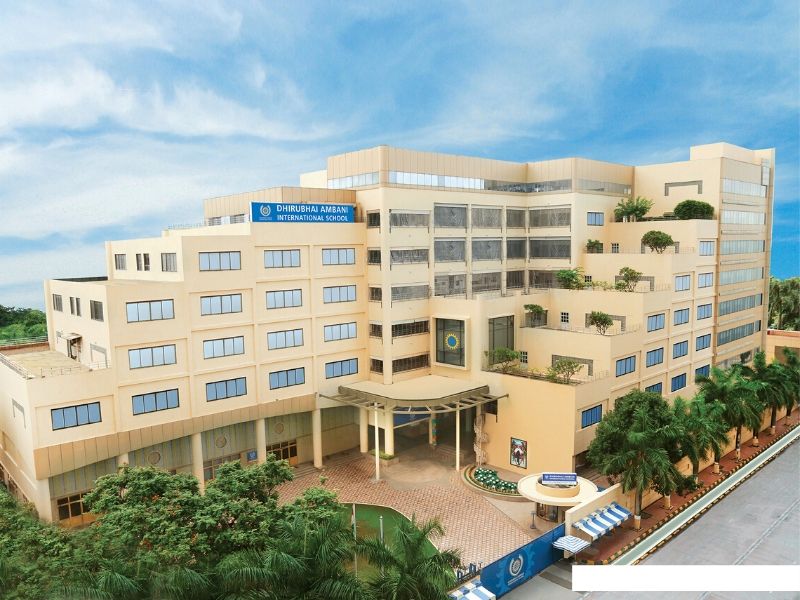To meaningfully celebrate the 5th Anniversary of EducationWorld, we deemed it incumbent upon ourselves to ask several educationists and industry leaders with proven commitment to improving the education system to write prescriptions for a renaissance of Indian education. Dilip Thakore reports
It’s a rising irreversible tide. though not a few within the political class and the nation’s powerful bureaucracy are in denial, there is an emerging consensus within India’s 5 million-strong academic community that the nation’s moribund, moth-eaten education system fashioned by Lord Macaulay over a century ago, needs an urgent makeover. With 21st century India burdened with the world’s largest population of illiterate citizens, an estimated 59 million children in the six-14 age group out of school, and the aggregate number of names and addresses of job-seekers in the registers of employment exchanges across the country having swollen to 41 million — not because there aren’t sufficient jobs, but because youth streaming out of the obsolete education system are unemployable — alarm sirens are wailing in all sections of Indian society.
The starkest evidence of the rising tide of anxiety about the quantity and quality of education being provided to genext is indicated by the unprecedented provision made in the Union budget presented to Parliament on July 8, to impose a 2 percent cess on all Central taxes to raise additional resources for elementary education. Moreover in his budget speech Union finance minister P. Chidambaram committed the 100-days-old United Progressive Alliance government at the Centre to raising the national outlay for education from the current 3.5-4 percent of GDP (gross domestic product) to 6 percent in the near future. Coterminously upgradation of the nation’s languishing public education and healthcare systems are top priority on the agenda of the National Advisory Council (NAC) chaired by Congress Party president Sonia Gandhi.
Inevitably, there is considerable scepticism about the declarations of intent and grand pronouncements made by governments at the Centre and in the states which are seldom followed up with policy implementation programmes. But even within civic society and the general public there is a never-before, new millennium awareness that quality education is the best social leveller and passport to gainful employment, affluence and social respect. Hence despite the rigours and travails of licence-permit raj which has migrated from industry to education, there’s a flurry of activity in terms of promotion of new schools, colleges and institutes of professional education, particularly in the private sector.
For example, during the decade past, over 100 next generation, capital-intensive, privately promoted primary-secondary schools such as the G.D. Goenka World School, Delhi; The International School, Bangalore; Pathways International, Gurgaon; The Selaqui School, Dehradun; Ecole Mondiale and Dhirubhai Ambani International, Mumbai among others which benchmark themselves globally, have sprung up across the country. Affiliated to international syllabus-setting and examination boards such as the Geneva-based IBO (International Baccalaureate Organisation) and UCLES (University of Cambridge Local Examinations Syndicate), these schools offer world-class secondary education which almost guarantees admission into the best universities worldwide.
Even in higher education the bar is continuously being raised given the steadily rising demand for quality higher — especially professional — study programmes. Again the pace is being set by a new genre of private sector ‘edupreneurs’ (the subject matter of EducationWorld‘s fourth anniversary cover story last November) who have promoted internationally benchmarked institutions of higher learning such as the S.P. Jain Institute of Management & Research and Narsee Monjee Institute of Management Studies in Mumbai; Amity University, Delhi; Indian School of Business and ICFAI Business School, Hyderabad; Mahavir Academy of Technical Sciences and Presidency College, Bangalore and the Great Lakes Institute of Management, Chennai, among numerous others.
Shut down HRD ministry!
SAUVIK CHAKRAVERTI is an alumnus of the London School of Economics and former senior assistant editor of The Economic Times. Currently Chakraverti is the convenor of the Liberal Study Group, Mangalore.
Shut down the union hrd (human resource destruction) ministry. The ministry is manned by propagandists of a failed experiment in state socialism. It has ensured there are no genuine knowledge workers in the entire education system, except bureaucrats. Its supervision of schools, colleges and universities should be revoked.
Dismantle all licensing requirements for education institutions. The education sector urgently needs to be set free. This will facilitate entry of competing private firms offering short courses that equip young people for vocations or professions, be it plumbing or baking into the education sector. The three R’s can also be easily taught, especially using computers.
Free the student community. In schools, colleges, universities and B-schools across the country students receive state-sponsored ‘education’. Such education churns out limited types of economic actors: bureaucrats, managers, accountants, lawyers, doctors, engineers. In the emerging free market economy, young people will find profitable niches as DJs, VJs, even tattoo artists. The burden of formal education — especially state-sponsored education — is inimical to creativity and intellectual freedom.
Revoke higher education subsidies. Higher education is a privilege, not a right. Those who actually produce knowledge should be free to work, teach and sustain their respective schools of thought. Every such school should sustain itself on its own resources as it would be fatal to academic freedom to expect or receive subsidies from the state.
Moreover some Indian edupreneurs are venturing overseas. The Manipal Education & Medical Group has promoted state-of-the-art medical schools in Nepal and Malaysia, and the S.P. Jain Institute, a campus in Dubai. And most spectacularly, India-born Sunny Varkey who runs a dozen secondary schools in Dubai and the UAE, has acquired 13 independent schools in Britain and could well be the world’s premier edupreneur.
This urgent flurry of activity within the hitherto somnolent education sector has ensured that the vital importance of qualitative education has permeated down to the lowest income groups across the subcontinent — a development accentuated by the promotion of the country’s 517 urban benchmarked Jawahar Navodaya Vidyalaya residential schools in rural India (see EW cover story August). Simultaneously it has focussed public attention upon hitherto arcane subjects such as syllabus design and curriculum development and shifted national attention from ritual to real education. Suddenly paper degrees and qualifications are not as important as professional and life skills which school leavers and college graduates must acquire within their institutions of learning.
Therefore the newly emergent consensus that reform of India’s Macaulayan system of education based on rote learning and memorisation rather than development of problem-solving and conflict-resolution skills requires urgent attention. And even as several specialist committees constituted by the Union ministry of human resource development are currently engaged in the process, the public interest demands a wider ambit for the national debate on syllabus and curriculum reform. To this end, to meaningfully celebrate the 5th anniversary of EducationWorld, we deemed it incumbent upon ourselves to ask several educationists and industry leaders with proven commitment to improving the education system to write prescriptions for a renaissance of Indian education.
Inevitably, prescriptions for the reform of India’s patently languishing, if not terminally ill education system by dedicated educationists in diverse professions and vocations differ widely. However on some points there is a broad consensus. The reforms implicitly or explicitly endorsed by all the seven eminent respondents are:
Liberalise and deregulate the education system to encourage promotion of new schools, colleges, vocational and other institutions of higher education.
To a greater or lesser degree all the respondents are in favour of addressing the supply side of education to eliminate capacity shortages which are the root cause of the overwhelming majority of the hundreds, if not thousands, of rackets which plague post-independence India’s education system. The learned justices of the Supreme Court agree. In its historic 2002 judgement in the TMA Pai Foundation Case (8 SCC 481), a full bench of the court expanded the right of minorities to “establish and administer educational institutions of their choice” as mandated by Article 30 of the Constitution of India, to all citizens.
This development prescription is strongly endorsed by liberal economist and writer Sauvik Chakraverti. “The education sector urgently needs to be set free. This will facilitate entry of private firms offering short courses that equip young people for vocations and professions — be it plumbing, or baking — into the education sector. The three R’s can also be easily taught by them using computers,” says Chakraverti (see box p.39).
Delicense higher education
Professor N.S. Ramaswamy is the former founder-director of the National Institute of Technical & Industrial Engineering (NITIE), Mumbai; the Jamnalal Bajaj Institute of Management Studies (JBIMS), Mumbai and the Indian Institute of Management, Bangalore (IIM-B). Currently he is the Bangalore-based founder-trustee of CARTMAN (Center for Action Research & Technology for Man Animal & Nature) and Indian Heritage Academy (IHA).
Institutional autonomy. Most universities are being controlled in some form or other through government nominees. They must be given total autonomy and freedom from government interference.
Rationalisation of legislation. Legislation relating to universities and the rules and regulations under them have remained substantially unchanged for the past 100 years. They should be simplified, rationalised for improving performance, efficiency and ensuring accountability.
Decentralise syllabus/ curriculum design. In the present system syllabuses and curricula are unchanged for years together. In IIMs and IITs, faculty design syllabuses, teach, set question papers, evaluate answer papers and recommend the award of degrees. Universities should switch to the IIT/ IIM system.
Optimise installed capacity. University buildings, classrooms, laboratories, faculty etc are utilised only for 180 days per year and only six hours per day. Universities/ colleges should function for 310 days annually and for 12 hours daily so that investments in infrastructure go a longer way.
Collegiate autonomy. Colleges with a track record of competence should be given the autonomy to prescribe their own curriculum, conduct examinations, and award degrees.
Delicence higher education. Only 6 percent of India’s 18-23 years age group avails tertiary education mainly because of capacity constraints. Therefore, private initiatives in providing collegiate education should be delicensed, and deregulated. Private colleges should be allowed to admit students and collect fees according to their need. Likewise privately promoted self financing institutions for all vocational education should be delicensed.
Tighten accreditation systems. To upgrade and maintain institutional quality, every department, college or institution should be strictly accredited by UGC and/ or AICTE.
Upgrade teacher-training programmes. Teacher training programmes should be sharply upgraded so that teachers have knowledge, skills as well as managerial competence.
Encourage holistic character-building education. The current education system merely imparts bookish knowledge with little attention to actual learning and understanding. Character-building is not taught at all. Syllabus/ curriculums should include regular lectures on Indian heritage, culture, philosophy, spirituality, national integration, inter-religious harmony, yoga, meditation, history of India etc.
Separate institutional administration from teaching. Administration should be separated from academic chores. Eminent teachers should not become vice chancellors if they don’t understand management concepts and skills.
Delicence higher education, confer institutional autonomy and decentralise syllabus design.
Quite evidently inspired by America’s great private universities such as Harvard, Stanford, Amherst among others which happily co-exist with government funded state universities, most respondents and educationists in general are veering around to the view that the process of delicensing and deregulating Indian education can begin in the institutions of higher learning. “Only 6 percent of India’s 18-23 years age group avails tertiary education mainly because of capacity constraints. Therefore private initiatives to provide collegiate education should be actively encouraged by government and deregulated. They should be allowed to admit students and collect fees according to their need. Likewise privately promoted self-financing institutions for all vocational education need to be urgently delicensed,” says Prof. N.S. Ramaswamy whose place in history as the founder-director of some of the nation’s most respected institutions of higher education is assured (see box p.40).
Central and state governments should change their roles within the education system, re-inventing themselves as facilitating and supervisory organisations.
Heavy-handed government intervention and participation in the education sector was sharply condemned by all respondents to this survey. There is a general consensus that having failed miserably during the past half century to upgrade education standards, the Central and state governments themselves should exit from syllabus design and mandate school examination boards to design syllabuses which test more than memory and rote learning ability. Comments Kabir Mustafi, former headmaster of Bishop Cotton School, Shimla who advocates that the Centre should promulgate a new National Education Policy: “The NEP should mandate ‘free-fall’ curriculums from nursery to class VIII… and direct all school examination boards to revise their syllabuses to test research, analysis, memory, comprehension and expression capabilities of students.” (see p. 44).
Use computers and technology
Fakir Chand Kohli, founder-director of Tata Consultancy Services — India’s largest infotech company in terms of annual sales revenue — is widely acknowledged as the father of India’s booming customised software development industry.
I believe that education in India is in crisis at all levels. There is a severe shortage of teachers, let alone good teachers, in schools and colleges. Most facilities and equipment are ancient. Can we do something about this? Is it possible to reset and reform the process of education? I am optimistic that we can set things right, with honest commitment.
Shortage of teachers. We need to experiment with trained aides to extend the reach of good teachers. This can be achieved by creating a pool of bright Plus Two level students, and training them for 12-18 months to become teaching associates who assist and share the workload of core teachers. Such associates should concurrently pursue higher education to become fully qualified teachers.
Tuitions. It’s no use decrying tuitions. Instead we can use technology to extend tuition. To handle the problem of ‘private tuition’ the knowledge and skills of good teachers can be captured through tutorial aids (CD-ROMs) and royalty can be paid to these teachers.
School dropouts. Dropouts can be reduced by lowering the cost of education, greater accessibility and by encouraging and providing skills-based training from class VIII simultaneously with studies. This would provide opportunities for gainful employment.
Sharing of resources. Through the wider use of computers and technology, curriculums and faculties can be shared by schools and colleges across the country.
Financing education. Education loan schemes can be made less burdensome and more attractive. Government should subsidise interest rates and encourage loans for professional education. Grants and subsidies for professional education should be withdrawn.
Encourage institutional autonomy. All reputable colleges should be given autonomy to work towards excellence. Affiliation to large universities, especially of engineering and medical colleges invariably lowers academic standards.
Teacher training, infrastructure and syllabuses need to be urgently upgraded.
The poor service conditions of the nation’s 5 million plus teachers attracted impassioned comment, given the vital importance of the teachers’ community in raising teaching-learning standards. Indeed infotech industry tycoon Azim Premji who has metamorphosed as a champion of over 100 million children across the country who are grossly under-served by the education system, makes teacher training and upgradation the dominant theme of his prescription for reforming Indian education. He recommends a complete revamp of teacher training syllabuses and continuous in-service training.
“Bring in contemporary understanding of how children learn and help teachers experience this understanding,” he advises.
And just how important teacher skills contemporisation is on Premji’s scale of education sector priorities is indicated by the estimated Rs.5 crore which the Azim Premji Foundation and Wipro Applying Thought in Schools programmes spend on teacher training programmes annually. (For Premji’s prescription see p.42).
Central and state governments should cooperate to devise a common school system.
One of the great in-built injustices of post-independence India’s school education system is that it provides inferior quality school education to the children of the poor, denying them equal opportunity in the employment marketplace. Children of the rich and the urban middle class are enrolled in CISCE and CBSE affiliated English medium schools while poor children are sentenced to government schools affiliated to the examination boards of state governments which usually offer the vernacular language as the medium of instruction.
Moreover it is well documented that state government schools are ill-administered, plagued with teacher absenteeism, textbook printing rackets and are bereft of basic infrastructure such as drinking water and toilets. “India has almost a million schools, 90 percent of them in the government sector. Government policy should be to strengthen the existing infrastructure and enhance faculty capacity while expanding the network. Policy prescriptions and budgets must recognise this sequence: strengthen then expand,” says Gopal Rajagopalan, chief executive of Manipal Universal Learning, the distance education delivery subsidiary of the highly respected Manipal Education and Medical Group.
Revamp teacher training curriculum
Azim Premji is the promoter chairman of the blue chip Wipro Corporation and the Azim Premji Foundation.
Government and the private sector should attract bright people into teaching. There is a dearth of talent in the teaching profession. If this means mandating higher salaries, so be it.
Universities should revamp the teacher-training curriculum. Bring in contemporary understanding of how children learn and help teachers experience this understanding.
Introduce in-service teacher training. Teacher training colleges and DIETs (District Institute of Education and Training) should be transformed into nodal points for continuous in-service teacher training, which has been given short shrift in this country. Given the context of only one-two teachers per every rural primary school, train teachers in multigrade/ multilevel teaching.
NCERT and SCERTs should transform into research organisations. The National Council for Education Research & Training and its counterparts in the states could provide valuable research inputs in the areas of curriculum, pedagogy etc and disseminate it to education boards, teacher training institutions, schools etc.
Utilise additional resources efficiently. Use the money raised through education cess to finance (a) an efficient mid-day meal scheme across the country, (b) to build infrastructure — compound walls, classrooms, toilets, libraries, and fill teacher vacancies etc for 1,000,000 schools in the country within the next two years.
Change assessment systems. The Central and state governments should mandate that school examination boards and bodies conducting entrance examinations for entry into higher education, change their assessment systems. They should move from merely testing rote learning to assessing conceptual understanding and application.
Government should reward competent teachers. Schools/ teachers who deliver better results on the redesigned assessment system of the boards and impart genuine learning and achievement should be celebrated and rewarded.
Integrate ICT into education. Use ICT (information & communication technology) to drive lower costs and consistent delivery of quality.
A national consensus needs to be developed to adopt English as the medium of instruction in Indian education.
The freedom conferred upon state governments to mandate their dominant languages as the medium of instruction, has extracted a heavy price upon the children of the poor and socially disadvantaged who have been denied job mobility and access to the emerging global employment marketplace. Now that “basic quality education” for all has been trumpeted by the UPA government at the Centre as its top priority, the patent fiction that state government schools dispensing vernacular education are on a par with CISCE and CBSE affiliated institutions should be given an expeditious burial. The plain truth that the passion for vernacular education is driven by textbook printing and publishing rackets, must be acknowledged. Quite obviously this subject is a politically sensitive hot potato which is why none of the high-profile prescription writers have touched upon it.
Address supply side
An alumnus of Madras and Bombay universities with over 25 years of experience in banking, financial services and infrastructure sectors, Gopal Rajagopalan is vice chairman and managing director of Manipal Universal Learning Pvt Ltd.
Focus on learning outcomes. The current emphasis is to assess information retention rather than learning effectiveness or outcomes.
Factor change. In a rapidly changing world, the how of learning becomes as important as the what of learning.
Address supply side. Indian education has traditionally been demand led. Governments at the Centre and in the states need to strengthen the supply side of education to enhance access. Distance learning and harnessing emerging technologies are possibly optimal methods of addressing equity, especially in developing economies.
Strengthen primary-secondary education. India has almost a million schools. Strengthen existing infra-structure and enhance faculty capacity while expanding the network. Government policy prescriptions and budgets must recognise the sequence: Strengthen, then expand.
Define role of government. Scarce resources need to be allocated for primary and secondary education. Government must strengthen the school system. Higher education must be opened for the private sector.
Plan for WTO. This is especially true for higher education. Barriers to entry are being dismantled and new technologies are delivering anytime, anywhere learning. Employers seek student quality in addition to accreditation.
Focus on the consumer. Education is a means to a livelihood. Syllabuses and curriculums must understand the future needs of the industrial and service sectors. Higher education institutions must engage with industry.
Regulations vs. supervision. Government must encourage self regulation. Government’s role should be restricted to supervision of education institutions in a transparent and unintrusive way.
Raise the annual outlay for education to 6 percent of GDP with immediate effect.
Though the UPA government has exhibited unprecedented urgency about upgrading standards of school education by imposing a 2 percent cess on all Central taxes and by promising to gradually raise the annual education outlay (Centre plus states) to 6 percent of GDP, the latter promise needs to be implemented sooner rather than later. Decades of under-investment in education has created shocking shortages of buildings, laboratories, libraries, even drinking water and sanitation facilities in the nation’s dilapidated education sector. Though the finance minister cites shortage of investible resources for implementing the 6 percent proposal immediately, it’s common knowledge that given political will (and sufficient public pressure), additional resources can be deployed into education by trimming non-merit subsidies (estimated at Rs.330,000 crore per year) to the middle class, and reducing defence expenditure (which requires making peace with our neighbours). In the final analysis a national consensus has to be built on the premise that higher education outlays are vitally important investments in the nation’s future.
New National Education Policy needed
An alumnus of Delhi and North Bengal universities, Kabir Mustafi is the former headmaster of Bishop Cotton School, Shimla. Currently he is a Delhi-based education consultant and principal designate of Scottish High International School, under construction in Gurgaon.
Change government role. The Central and state governments must play a monitorial role; not as cash investors but as referral and adjudicating organisations.
Government must retreat from syllabus design. Central and state governments have to dissociate from dictating syllabi and curriculums to ascertaining whether or not government schools and institutions of higher education are delivering learning in their classrooms.
New NEP required. A new National Education Policy needs to be written. It should:
(i) Empower local bodies such as SDMCs (School Development Monitoring Committees) and panchayats so that teachers and boards are accountable to the public; (ii) Upgrade teacher skills by establishing NDA (National Defence Academy) or ASCI (Administrative Staff College of India) type academies for three-five year training and refresher courses with stipends; (iii) Ban arbitrary teacher transfers; (iv) Draw up stringent but transparent recognition and accreditation norms as per CISCE/ CBSE/ NAAC/ AICTE standards while delicensing private initiatives in education.
Revise school syllabi. The NEP should direct all school examination boards to revise their syllabuses to test research, analysis, memory, comprehension and expression capabilities of students.
Standardise college admissions. The new NEP needs to mandate a single SAT type examination for college admission and a GRE/ GMAT version for postgrad admissions. Modifications to existing successful models are entirely feasible.
Targetted subsidies in higher education. The blanket subsidisation of tertiary education needs to be replaced with need-based scholarships, grants and financial aid.
Involve local communities. The upgradation of teacher salaries and infrastructure for schools not well endowed, should be entrusted to local communities including corporates, against tax holidays and other fiscal benefits.
Critical need to update syllabuses and curriculums in tertiary education.
There is a general consensus within Indian academia that higher education syllabuses prescribed by the University Grants Commission and universities are woefully past their sell-by dates if not obsolete — especially in government-run arts, science and commerce colleges. It should be a high priority of the Union HRD ministry and UGC to constitute task forces comprising respected academics, businessmen and social scientists to contemporise college and varsity syllabuses and bring them on a par with institutions of higher learning in Britain and the US, which attract a growing number of students from India.
“Industry needs employable graduates”
An industrialist and educationist, Dr. Palani G. Periasamy is an economics alumnus of Madras University and University of Pittsburg, and founder-president of the PGP College of Arts & Science, PGP Polytechnic, PGP College of Engineering & Technology, PGP Industrial Training Institute, all based in Namakkal, Tamil Nadu.
Task force for new education policy. A comprehensive education policy for the country for all levels of education, taking into account the recent changes and requirements of a globalised environment is urgently required. It should be drafted by an expert committee drawn from India and abroad.
Rural education thrust. Central and state governments should draw up incentive and grants-in-aid programmes to promote centres of quality education in rural areas across the country. Education opportunities need to be spread out rather than concentrated in isolated geographic locations.
Government and industry should boost academic R&D. Continuous R&D (research and development) is the measure of national development. Government and industry should synergise to sponsor research efforts with the former providing liberal tax incentives.
Upgrade tertiary level syllabuses and curriculums. Higher education should be made relevant to meet industry requirements, so that students make a smooth transition from academics to industry. Industry needs employable graduates.
Liberalise and deregulate education sector. Diverse rules and regulations prescribed by monitoring agencies in higher education inhibit growth and excellence in educational institutions. They should be given full autonomy for self-development while the national accreditation process must become more stringent.
Integrate the latest ICT (information communication technologies) into the education system. The rapid growth and development of the infotech, particularly the software development and electronic communications industries, is one of the few success stories of Indian industry in post-independence India. This great reservoir of skills and expertise offers the opportunity to utilise them for the spread of quality education through distance learning technologies. “Through the wider use of computers and technology, curriculums and faculties can be shared by schools and colleges across the country,” recommends F.C. Kohli the legendary vice chairman emeritus of Tata Consultancy Services who pioneered the growth and development of India’s computer software industry during his three decade stewardship (1968-2002) of this Mumbai-based trailblazing company (see p.41).
Though this 5th anniversary cover story read together with the prescriptions of proven professionals and educationists who have volunteered to cooperate with us to write this first-of-its-kind feature covers considerable ground, a glaring lacuna is that the route map of the individual entrusted by the people of India to manage the nation’s education system, viz, Union minister of human resource development, the Rt. Hon’ble Arjun Singh is a conspicuous omission. This is not for want of effort on our part. For the past three months leading up to this issue we have continuously attempted to interview the minister. But over a dozen letters and over 40 long-distance and equal number of local telephone calls from Education World‘s Delhi-based correspondents to the minister’s office and repeated calls to Sudip Banerjee, additional secretary, B.N. Singh, S.N. Singh and several other flunkeys within the HRD ministry, haven’t merited a single reply or telephone call. Likewise a faxed questionnaire (see box) remains wholly ignored. Official indifference, arrogance and unwillingness to engage in constructive debate — regrettably a characteristic of the new UPA government as much as it was of its predecessor BJP-led NDA administration — is a measure of the challenge which confronts the growing community of reformers intent upon cleansing the augean stables of the nation’s education system.
Questions Arjun Singh refuses to answer
1. The recently released human Development Report of UNDP indicates that India has the largest national population of illiterates in the world. It also confirms that despite a lower allocation as a percentage of GDP for education, 85 percent of adult Chinese are literate. What’s your comment?
2. The newly inducted UPA government has imposed a 2 percent cess on all Central taxes to raise additional funding for education. What is the additional revenue expected this year? Moreover what additional safeguards is your ministry taking to ensure optimal deployment of the incremental revenue for primary education?
3. What is the UPA government’s stand on a common school system for India which was recommended by the Kothari Commission way back in 1966?
4. The children of the poor and socially disadvantaged have been consistently denied English medium school education. Is there any re-thinking on this issue within the HRD ministry?
5. Given the abysmal record of government at the Centre and in the states in managing schools, to what extent are you in favour of leasing government schools to tried and tested NGOs?
6. To what extent, if any, do you subscribe to the view that the logic of liberalisation and deregulation needs to be applied to Indian education? Do you intend to revive the Private Universities Bill pending in Parliament since 1985?
7. Your critics allege that you are pre-occupied with ‘detoxifying’ education institutions rather than addressing substantive education issues. What’s your response?
8. What are the major initiatives planned by the UPA government to ensure that India will attain the United Nations Education For All goal by 2015 to which it is committed?
Nevertheless for those whose goals are fixed and purpose is clear, ours is but to do our best. One of the most valuable lessons of once high-potential India’s failed economic development effort is that enterprises of great pith and moment succeed despite government, seldom because of it.
With Gaver Chatterjee (Mumbai) & Hemalatha Raghupathi (Chennai)


















